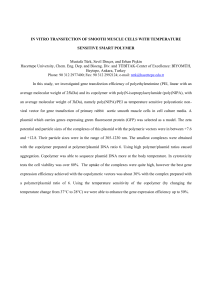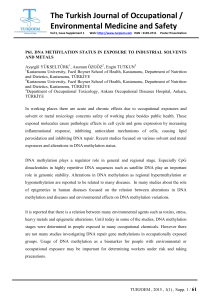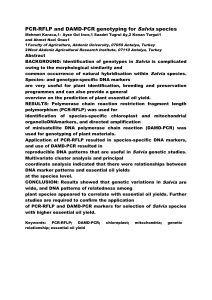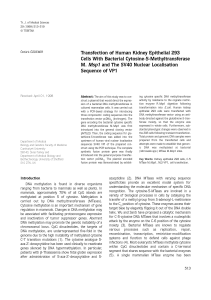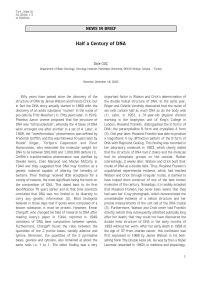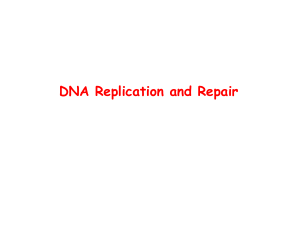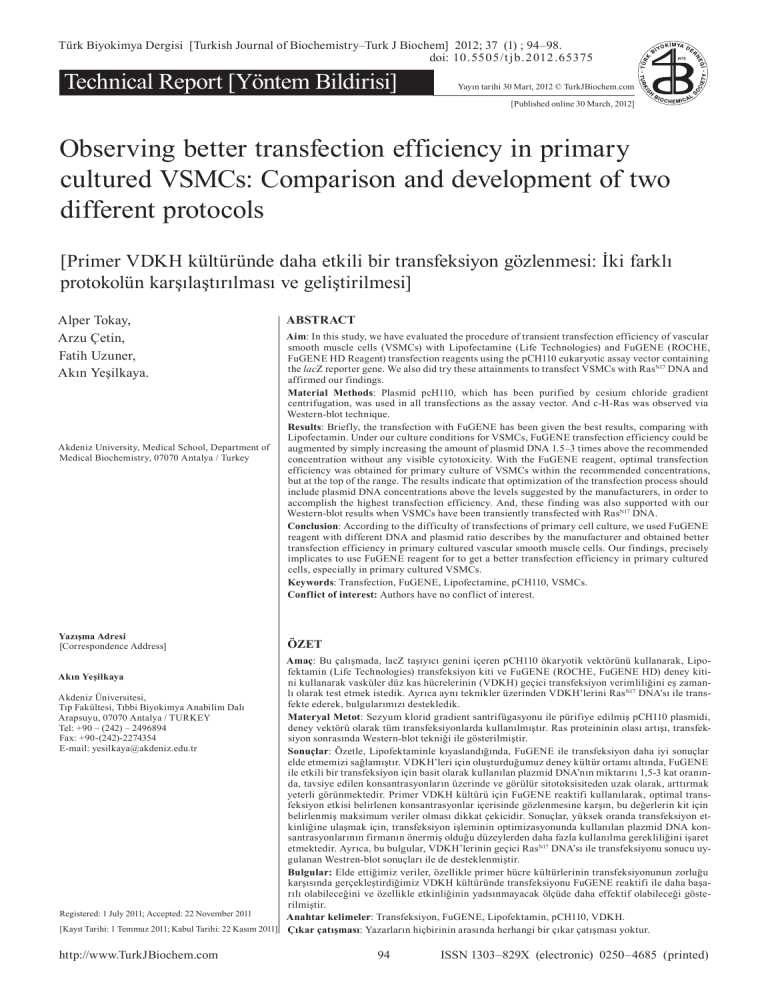
Türk Biyokimya Dergisi [Turkish Journal of Biochemistry–Turk J Biochem] 2012; 37 (1) ; 94–98.
doi: 10.5505/t jb. 2012.65375
Technical Report [Yöntem Bildirisi]
Yayın tarihi 30 Mart, 2012 © TurkJBiochem.com
[Published online 30 March, 2012]
Observing better transfection efficiency in primary
cultured VSMCs: Comparison and development of two
different protocols
[Primer VDKH kültüründe daha etkili bir transfeksiyon gözlenmesi: İki farklı
protokolün karşılaştırılması ve geliştirilmesi]
Alper Tokay,
Arzu Çetin,
Fatih Uzuner,
Akın Yeşilkaya.
Akdeniz University, Medical School, Department of
Medical Biochemistry, 07070 Antalya / Turkey
Yazışma Adresi
[Correspondence Address]
ABSTRACT
Aim: In this study, we have evaluated the procedure of transient transfection efficiency of vascular
smooth muscle cells (VSMCs) with Lipofectamine (Life Technologies) and FuGENE (ROCHE,
FuGENE HD Reagent) transfection reagents using the pCH110 eukaryotic assay vector containing
the lacZ reporter gene. We also did try these attainments to transfect VSMCs with RasN17 DNA and
affirmed our findings.
Material Methods: Plasmid pcH110, which has been purified by cesium chloride gradient
centrifugation, was used in all transfections as the assay vector. And c-H-Ras was observed via
Western-blot technique.
Results: Briefly, the transfection with FuGENE has been given the best results, comparing with
Lipofectamin. Under our culture conditions for VSMCs, FuGENE transfection efficiency could be
augmented by simply increasing the amount of plasmid DNA 1.5–3 times above the recommended
concentration without any visible cytotoxicity. With the FuGENE reagent, optimal transfection
efficiency was obtained for primary culture of VSMCs within the recommended concentrations,
but at the top of the range. The results indicate that optimization of the transfection process should
include plasmid DNA concentrations above the levels suggested by the manufacturers, in order to
accomplish the highest transfection efficiency. And, these finding was also supported with our
Western-blot results when VSMCs have been transiently transfected with RasN17 DNA.
Conclusion: According to the difficulty of transfections of primary cell culture, we used FuGENE
reagent with different DNA and plasmid ratio describes by the manufacturer and obtained better
transfection efficiency in primary cultured vascular smooth muscle cells. Our findings, precisely
implicates to use FuGENE reagent for to get a better transfection efficiency in primary cultured
cells, especially in primary cultured VSMCs.
Keywords: Transfection, FuGENE, Lipofectamine, pCH110, VSMCs.
Conflict of interest: Authors have no conflict of interest.
ÖZET
Amaç: Bu çalışmada, lacZ taşıyıcı genini içeren pCH110 ökaryotik vektörünü kullanarak, Lipofektamin (Life Technologies) transfeksiyon kiti ve FuGENE (ROCHE, FuGENE HD) deney kitiAkın Yeşilkaya
ni kullanarak vasküler düz kas hücrelerinin (VDKH) geçici transfeksiyon verimliliğini eş zamanlı olarak test etmek istedik. Ayrıca aynı teknikler üzerinden VDKH’lerini RasN17 DNA’sı ile transAkdeniz Üniversitesi,
fekte ederek, bulgularımızı destekledik.
Tıp Fakültesi, Tıbbi Biyokimya Anabilim Dalı
Materyal Metot: Sezyum klorid gradient santrifügasyonu ile pürifiye edilmiş pCH110 plasmidi,
Arapsuyu, 07070 Antalya / TURKEY
deney vektörü olarak tüm transfeksiyonlarda kullanılmıştır. Ras proteininin olası artışı, transfekTel: +90 – (242) – 2496894
Fax: +90-(242)-2274354
siyon sonrasında Western-blot tekniği ile gösterilmiştir.
E-mail: yesilkaya@akdeniz.edu.tr
Sonuçlar: Özetle, Lipofektaminle kıyaslandığında, FuGENE ile transfeksiyon daha iyi sonuçlar
elde etmemizi sağlamıştır. VDKH’leri için oluşturduğumuz deney kültür ortamı altında, FuGENE
ile etkili bir transfeksiyon için basit olarak kullanılan plazmid DNA’nın miktarını 1,5-3 kat oranında, tavsiye edilen konsantrasyonların üzerinde ve görülür sitotoksisiteden uzak olarak, arttırmak
yeterli görünmektedir. Primer VDKH kültürü için FuGENE reaktifi kullanılarak, optimal transfeksiyon etkisi belirlenen konsantrasyonlar içerisinde gözlenmesine karşın, bu değerlerin kit için
belirlenmiş maksimum veriler olması dikkat çekicidir. Sonuçlar, yüksek oranda transfeksiyon etkinliğine ulaşmak için, transfeksiyon işleminin optimizasyonunda kullanılan plazmid DNA konsantrasyonlarının firmanın önermiş olduğu düzeylerden daha fazla kullanılma gerekliliğini işaret
etmektedir. Ayrıca, bu bulgular, VDKH’lerinin geçici RasN17 DNA’sı ile transfeksiyonu sonucu uygulanan Westren-blot sonuçları ile de desteklenmiştir.
Bulgular: Elde ettiğimiz veriler, özellikle primer hücre kültürlerinin transfeksiyonunun zorluğu
karşısında gerçekleştirdiğimiz VDKH kültüründe transfeksiyonu FuGENE reaktifi ile daha başarılı olabileceğini ve özellikle etkinliğinin yadsınmayacak ölçüde daha effektif olabileceği gösterilmiştir.
Registered: 1 July 2011; Accepted: 22 November 2011
Anahtar kelimeler: Transfeksiyon, FuGENE, Lipofektamin, pCH110, VDKH.
[Kayıt Tarihi: 1 Temmuz 2011; Kabul Tarihi: 22 Kasım 2011] Çıkar çatışması: Yazarların hiçbirinin arasında herhangi bir çıkar çatışması yoktur.
http://www.TurkJBiochem.com
94
ISSN 1303–829X (electronic) 0250–4685 (printed)
Introduction
Thus, we describe here the optimized transfection parameters for both Lipofectamine and FuGENE with primary cultured VSMCs.
The transfer of recombinant genes into a variety of eukaryotic cultured cells, commonly known as transfection, is an extensively used approach in gene expression
studies. A large number of plasmid DNA delivery methods have been developed for mammalian cells. Calcium phosphate precipitation and DEAE-dextran transfection were two of the early methods developed for DNA
delivery [1]. These methods appear to facilitate DNA
binding to cell membranes and entry of DNA into the
cell via endocytosis. Both methods, as well as electroporation, tend to have harmful effects on the cells [2].
Transfection by cationic liposomes is better tolerated by
the cells and has the additional advantage of simplicity.
Cationic liposomes interact efficiently with negatively
charged nucleic acid molecules and DNA-bound lipids
associate with the cell membrane, leading to DNA internalization. Since these synthetic molecules were first
introduced by [3], and the number and variety of commercially available forms have greatly increased.
As demand for rapid, high efficiency transfections becomes more intense, a number of other products, including non-liposomal lipids, synthetic polymers, etc., have
been developed that mediate transport of genes into
cells. However, a problem associated with the majority
of non-viral gene-delivery agents is their relatively low
transfection efficiency [4].
A wide variety of factors can influence transfection efficiency. Essential parameters which should be taken into
consideration when optimizing transfection efficiency
include cell type or cell line to be used, culture conditions, and transfection vector. For instance, certain cell
types or lines are intrinsically easier to transfect than others, although the exact reason for these differences is
currently unknown. Even clonal variability in DNA uptake has been reported in mouse L cells [5]. Another important factor influencing the success or failure of transfection is the quality of the transferred DNA, as well as
its size, configuration, and quantity.
In order to study the effects of Ras transfection involved in Phosphoinositede-3 kinase-Akt protein kinase B (PI3-K-Akt/PKB) signaling, it was essential for
us to transiently introduce recombinant plasmid DNA
into the primary cultured VSMCs [6] with high efficiency. We evaluated two transfection systems: FuGENE (ROCHE, FuGENE HD Reagent) and Lipofectamine (Life Technologies). In view of the fact that the majority of cell lines can survive in a serum-free environment for a limited time, we decided to try transfections
with the Lipofectamine reagent, which is recommended
in the absence of serum (with Opti-MEM) for maximal
activity. On the other hand, it is well known that transfections in the presence of serum (%1) may accomplish
better cell growth, function and viability, and may reduce the cytotoxic effects of transfection reactions [7].
For these reasons, we also tested the FuGENE reagent.
Turk J Biochem, 2012; 37 (1) ; 94–98.
Materials and Methods
Plasmid DNA
Plasmid pCH110 (gifted from Uğur Yavuzer, PhD., Akdeniz Univ. Sch. of Med. Dept. of Physiology) was used
in all transfections as the assay vector. It contains a functional lacZ gene and is routinely used for screening and
normalizing expression in eukaryotic cells. The vector
was purified by cesium chloride gradient centrifugation and its concentration determined spectrophotometrically.
Cell culture
VSMCs were maintained in Dulbecco’s modified
Eagle’s medium (DMEM, Life Technologies), supplemented with 10% fetal bovine serum, allowed to grow
near confluency and harvested with trypsin. Cells were
then pelleted by centrifugation and resuspended in fresh
growth medium. Viable cell counts were determined by
trypan blue staining and 2.5x105 or 1x106 VSMCs were
seeded per well in either six well or 35 mm tissue culture plates in 2 ml of complete growth medium. Cells
were incubated overnight at 37 ºC in a 5%CO2 atmosphere to give 70–80% confluence before the transfection.
For VSMCs, we tried lower and higher cell plating densities, but the values mentioned above resulted in optimal culture confluence recommended for transfections.
Therefore, this seeding protocol was maintained throughout all the experiments presented.
In situ β-galactosidase staining
Transfection efficiency was determined by in situ staining of cells expressing β-galactosidase (β-gal) [8].
Twenty-four hours after transfection, cells were washed with Phosphate buffer saline (PBS), fixed for 5 min
in 2% formaldehyde, 0.2% glutaraldehyde in PBS at
room temperature, rinsed three times with PBS and stained overnight at 37 ºC with 0.1% X-gal, 5 mM potassium ferricyanide, 5 mM potassium ferrocyanide, 2 mM
MgCl2 in PBS. Stained cells were photographed using
Olympus E-330 digital camera on an Olympus CKX41
inverted microscope. Results are presented as the average of three independent transfection experiments for
each plasmid DNA concentration. The percent of stained cells was determined from manual counts of photographed wells (from three separate fields per transfection
with at least 100 cells counted per field).
Ras Western-Blot Analysis
VSMCs were directly lysed in Laemmle buffer containing 10 mM dithiothreitol. c-H-Ras was separated on
15% polyacrylamide gel and electroblotted to nitrocellulose membranes. Ras was detected using anti-c-H-Ras
95
Tokay et al
1-6 μg pCH110 and observed that 3:6 and 4:8 DNA to
FuGENE ratios resulted in high transfection efficiencies, while some cytotoxicity was detected at 6:12 (Table
1 and Figure 1A). Regarding length of exposure of cells
to complexes, we tested 5, 16 and 24 h with 3 μg and 4
μg pCH110 and a 4:8 ratio of DNA to FuGENE (data not
shown). The highest transfection efficiency without visible toxic effects was detected after 24 h. Therefore, in
all subsequent experiments a ratio of 4 μg DNA to 8 μl
FuGENE was used, and complexes were incubated with
cells for 24 h.
Lastly, different concentrations of plasmid DNA were
tested within the recommended range of 1–2 μg for 35
mm dishes, as well as above this range (Table 1 and Figure 1). Unexpectedly, we obtained the highest transfection efficiency for VSMCs using plasmid concentrations
2–3 times above the suggested values: for Lipofectamine transfection, this was an average of 12 % transfected cells with 4 μg pCH110 and for FuGENE transfection, an average of 66 % transfected cells with again 4 μg
pCH110 (Figure 2). Attempts were made to further increase the quantity of DNA (with 5 and 6 μg of pCH110),
but excessive cell death was observed in both transfection method due to the cytotoxic effects of LipofectamineDNA and FuGENE-DNA complexes (Figure 1).
After having the best transfection ratios and the efficiency, we transfected our VSMCs with a RasN17 DNA by
using FuGENE reagent. Afterwards, the Western-blot
results were promising (Figure 3).
We are aware that transfection techniques may modify
cellular activity; particularly those of the cell membrane, so functional assays should be taken into account in
addition to transfection efficiency [9, 10]. For this reason, it is important to check morphologically transformed cells under high magnification during transfection
for signs of cytotoxicity. However, as we have observed
decreased cell survival percentages after being used the
DNA:FuGENE and/or Lipofectamine ratios of 5:10 and
6:12, it can easily be told that using higher FuGENE and/
or Lipofectamine concentrations could become toxic for
cultured cells (Figure 1).
In conclusion, under our culture conditions for VSMCs,
transfection efficiency can be augmented simply by increasing the amount of plasmid DNA. Therefore, optimization of the transfection process should include plasmid DNA 2–3 times above the recommended concentration (FuGENE) in order to accomplish the highest efficiency of transfection. And by the means of our assays, the
transfection done by FuGENE reagent has become more
effective in our primary cultured VSMCs as compared
with Lipofectamine; especially comparing the results, as
observed in the experiments of which having been done
with using the ratio of 4:8 (DNA:FuGENE and /or Lipofectamine), we obtained better transfection efficiency
and higher cell survival percentage by using FuGENE
reagent (Figure 1).
antibody (1:500, Calbiochem, US). Primary antibody
was detected with horseradish peroxidase-coupled secondary antibody (1:4000, Sigma, US) and a chemiluminescent substrate (Bio-Rad, US).
Statistical analysis
SPSS statistical software Version 11.0.1 was used for
statistical analysis. All data were expressed as mean
±S.E.M. Normally distributed data were analyzed by
one-way ANOVA and were Bonferroni-corrected for repeated measures over time. All experiments were performed at least 3 times. Representative results of Western blot analysis are shown. A probability value P <0.05
was regarded as significant.
Results and Discussion
In our initial experiments, we tried the method as described in the study done by Weber and et al. [6] with
VSMCs and obtained an average of 1% transfection with
low viability, which low efficiency is considering the total amount of plasmid DNA used (40 μg). This is time
consuming method giving low transfection efficiency,
so we evaluated two further systems: Lipofectamine
(Life Technologies) and FuGENE (ROCHE).
In order to achieve optimal transfection efficiency we
varied all parameters as per the manufacturers’ guidelines and directions. For Lipofectamine we tested four different lipid volumes (4, 6, 8 and 10 μl) within the suggested range of 2–5 μg pCH110 and 6 h exposure of cells to
the complexes. Even, the viability was high and the observed toxicity of cells was low, efficiency of transfection was not satisfied (data not shown). Each transfection
was carried out in the absence of serum; we used OptiMEM I Reduced Serum Medium (Life Technologies)
during exposure of cells to DNA-liposome complexes.
We also tried three different exposures of cells to the
complexes: 3, 5 h and overnight with 3 and 4 μg pCH110
and 6-8 μl FuGENE reagent, and found out that 6 h, followed by addition of complete growth medium for 24 h,
was optimal under our conditions (data not shown).
Finally, we tested concentrations of plasmid DNA within the 1–2 μg suggested by the manufacturer for 6-well
dishes. Plasmid DNA concentrations below and above
the recommended levels were also tested (Table 1 and
Figure 1). Using Lipofectamine, the highest transfection
efficiency averaging 12,3 % transfected VSMCs was obtained with 4 μg pCH110 DNA, which is not within the
recommended range, even an average of 9,4 % was seen
using 3 μg Plasmid DNA with VSMCs, which is also
above the suggested amount. Using DNA below 2 μg for
VSMCs resulted in a drastic decrease in transfection efficiency (Table 1 and Figure 1B).
In order to maximize transfection efficiency using FuGENE, the following parameters were optimized: ratio
of DNA to FuGENE reagent, length of exposure of cells
to complexes, and quantity of plasmid DNA. We tested
Turk J Biochem, 2012; 37 (1) ; 94–98.
96
Tokay et al
Table 1. Transfection efficiency of Lipofectamine and FuGENE transfection reagents with various plasmid DNA (pCH110) concentrations in
VSMCs.
DNA (mg)
FuGENE (ml)
Lipofectamine (ml)
%Transfected cells
1
2
2
3.1 ±0.4
16.3
4.6 ±0.3
20.19
2
4
4
5.2 ±1.3
22.6
10.7 ±0.7
24.7
3
6
6
9.4 ±1.7
43.9
33.2 ±2.4
57.9
4
8
8
20.2 ±1.2
81.3
66.3 ±4.3
92.4
5
10
10
7.1 ±2.1
29.2
21.2 ±3.1
44.3
6
12
12
5.8 ±0.6
23.7
14.4 ±1.9
28.6
With Lipofectamine
Cell survival %after
transfection with Lipofectamin
With FuGENE
Cell survival %after transfection with
FuGENE
Note: data are presented as the average of three independent transfections. % Transfected cells are defined as the percentage of cells exhibiting
b-gal expression 24 h after transfection. Counts of three separate fields for each transfection, with at least 100 cells counted per field, were made
for each independent experiment. Cell survival percentages are defined as the un-stained cells, which were counted at the same separate fields
chosen for each transfection and independent experiment.
Figure 2. Non-transfected, control VSMCs (A). Typical view of a
VSMC stained with b-Gal after being transfected with pCH110 DNA
(B). VSMCs transfected with a ratio 1:2 (1 mg DNA/2 ml Transfection
reagent) by using Lipofectamine reagent (Red arrows, marking the
transfected cells while the black arrows showing the non-transfected
VSMCs) (C). Best transfection efficiencies observed by using
FuGENE HD reagent (D; a ratio of 3:6, E; a ratio of 4:8)
Figure 1. Transfection efficiency and cell survival of VSMCs at the
indicated DNA:FuGENE (A) and DNA:Lipofectamine (B) ratios,
exhibiting b-gal expression 24 h after transfection. Counts of three
separate fields for each transfection, with at least 100 cells counted
per field, were made for each independent experiment. Cell survival
percentages are defined as the un-stained cells, which were counted at
the same separate fields chosen for each transfection and independent
experiment.
Turk J Biochem, 2012; 37 (1) ; 94–98.
Figure 3. RasN17 transfected VSMCs, has observed giving nearly
3 fold more Ras activity comparing the cells only stimulated with
Angiotensin II (Ang II). The transfection has done with FuGENE
reagent by the means of ratio 4:8.
97
Tokay et al
Acknowledgement
This work was supported in part by funding from
the Akdeniz University Research Foundation
(2007.03.0122.002) and also by TUBITAK – Medical
Sciences Research Group [106274 – (SBAG-3485)].
Conflict of interest: Authors have no conflict of interest
References
[1] Pari GS, Keown WA. (1997) Experimental strategies in efficient transfection of mammalian cells. Calcium phosphate and
DEAE-dextran. Methods Mol Biol 62:301-306.
[2] Smith JG, Walzem RL, German JB. (1993) Liposomes as agents
of DNA transfer. Biochim Biophys Acta 1154 (3-4):327-340.
[3] Felgner PL, Gadek TR, Holm M, Roman R, Chan HW, Wenz M,
et al. (1987) Lipofection a highly efficient, lipid-mediated DNAtransfection procedure. Proc Natl Acad Sci USA 84 (21):74137417.
[4] Chen QR, Zhang L, Luther PW, Mixson AJ. (2002) Optimal
transfection with the HK polymer depends on its degree of
branching and the pH of endocytic vesicles. Nucleic Acids Res
30 (6):1338-1345.
[5] Corsaro CM, Pearson ML. (1981) Competence for DNA transfer
of ouabain resistance and thymidine kinase: clonal variation in
mouse L-cell recipients. Somatic Cell Genet 7 (5):617-630.
[6] Weber TJ, Ramos KS. (1997) c-Ha-rasEJ transfection in vascular smooth muscle cells circumvents PKC requirement during
mitogenic signaling. Am J Physiol 273 (4 Pt 2):H1920-1926.
[7] Ciccarone V, Hawley-Nelson P, Jessee J. (1993) Cationic
liposome-mediated transfection: Effect of serum on expression
and efficiency. Focus 15:80-83.
[8] Sanes JR, Rubenstein JL, Nicolas J.F. (1986) Use of a recombinant retrovirus to study post-implantation cell lineage in mouse
embryos. EMBO J 5 (12):3133-3142.
[9] Baker EA, Vaughn MW, Haviland D L. (2000) Choices in transfection methodologies: transfection efficiency should not be the
sole criterion. Focus 22:31-33.
[10] Offermanns S, Simon MI. (1995) G alpha 15 and G alpha 16 couple a wide variety of receptors to phospholipase C. J Biol Chem
270 (25):15175-15180.
Turk J Biochem, 2012; 37 (1) ; 94–98.
98
Tokay et al

